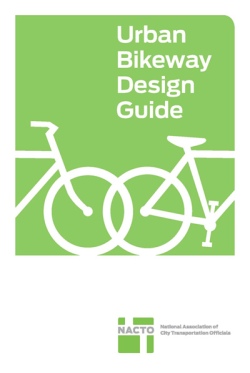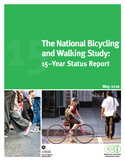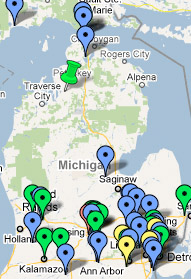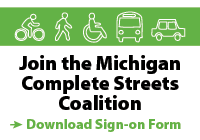You are currently browsing the tag archive for the ‘bicycling’ tag.
 Earlier this month, Federal Highway Administration (FHWA) announced support for two guidelines, which can help communities, especially more urban ones, plan and design safe and convenient facilities for those who walk and/or bike.
Earlier this month, Federal Highway Administration (FHWA) announced support for two guidelines, which can help communities, especially more urban ones, plan and design safe and convenient facilities for those who walk and/or bike.
In the recent memorandum, the FHWA encourages its division throughout the nation to consider relying upon The National Association of City Transportation Officials (NACTO) Urban Bikeway Design Guide and the Institute of Transportation Engineers (ITE) Designing Urban Walkable Thoroughfares.
These guides build upon The American Association of State Highway and Transportation Officials (AASHTO) “green book”, which is the primary national resources for planning, designing, and operating bicycle and pedestrian facilities.
“The FHWA’s support for the NACTO guidelines gives communities and our state DOT an additional toolkit to help them provide safe and effective infrastructure that better serves bicyclists.” said John Lindenmayer, Advocacy & Policy Director for the League of Michigan Bicyclists. “Providing safe bicycle infrastructure that connects people to places goes along way to improve a bicyclists’ comfort level and overall feeling of safety on the road. These innovative bikeways certainly can play a big role in increasing ridership, which in and of itself, can help reduce the number of bicycle crashes within a community. It’s a win-win. This is an exciting opportunity for Michigan communities and LMB strongly encourages road agencies across the state to incorporate these design standards where appropriate.”
NACTO, which is an association of 15 major US cities (including Detroit) formed to exchange transportation ideas, insights, and practices and cooperatively approach national transportation issues, has published two editions of its bikeway design guide with with another edition set to be released on September 23, 2013. Unlike AASHTO’s more traditional guide, NACTO’s include protected bicycle lanes and other innovative best practices.
The FHWA memorandum also highlighted Michigan as a case study to illustrate use of treatments illustrated in the NACTO Guide by State or local DOTs:
Example 1: Michigan DOT’s Buffered Bike Lanes
One of the innovative bicycle facilities discussed in the NACTO Urban Bikeway Design Guide is buffered bike lanes. Buffered bike lanes create more space between motor vehicles and bicycles by delineating extra space between the bike lane and parked cars and/or a motor vehicle lane. Buffered bike lanes can be implemented if the pavement markings and channelizing devices are compliant with the MUTCD (see Bicycle Facilities and the Manual on Uniform Traffic Control Devices). Michigan DOT developed a video that describes their efforts to install buffered bike lanes in Oakland County (see Northwestern Highway Bicycle Lane: A Safer Place to Ride). Michigan DOT also developed a brochure that explains buffered bike lanes to the public (see What Every Michigan Driver Should Know About Bike Lanes).
CONTACT: Jeff Cranson, MDOT Director of Communications, 517-335-3084
MDOT promotes on-road bicycling facilities
August 19, 2011 — The Michigan Department of Transportation (MDOT) is sponsoring “Training Wheels” courses around the state designed to educate communities interested in providing on-road bicycle facilities for their residents and visitors. The five-hour course includes both classroom and outdoor instruction.
The courses will be offered in the following areas:
- Sept. 12 in Three Rivers ([email protected])
- Sept. 13 in Dewitt Township ([email protected])
- Sept. 14 in Big Rapids ([email protected])
- Sept. 15 in Park Township/Holland ([email protected])
- Sept. 26 in Dearborn ([email protected])
- Sept. 27 in Berkley ([email protected])
- Sept. 28 in Rochester ([email protected])
- Sept. 29 in Lapeer ([email protected])
“Training Wheels” is designed to show communities how to integrate bike facilities into existing infrastructure to make bicycling safe and convenient, providing alternate transportation that make roads more complete for everyone. Classroom instruction using a guide produced by the American Association for State Highway Officials (AASHTO) is followed by an on-road, on-bike portion. The outdoor segment provides participants a firsthand look at the benefits of providing an alternative mode of travel that does not require expensive facilities for communities to build or maintain.
The “Training Wheels” courses are intended for city, township and county managers; council members; engineers; and related design and planning staff. Registration is required. A bicycle and helmet also are required and may be rented; bicycles and helmets must be ordered in advance. Registration deadlines vary with locations. For details, contact Cynthia Krupp at 517-335-2923, or by e-mail at [email protected].
 After being featured on Streetsblog DC last week, we are pleased to inform our readers of an upcoming Training Wheels: On-Road Bicycle Facility Design Training, that will take place in Rochester, MI September 28, 2011.
After being featured on Streetsblog DC last week, we are pleased to inform our readers of an upcoming Training Wheels: On-Road Bicycle Facility Design Training, that will take place in Rochester, MI September 28, 2011.
WHAT:
Training Wheels is an educational course on the planning and design of on-road bicycle facilities sponsored by the Michigan Department of Transportation (MDOT). It will consist of two hours of classroom instruction on the AASHTO Guide for the Development of Bicycle Facilities, followed by an on-road, on bike portion. During this portion we will casually ride through the community, analyzing types of on-road facilities available. There will be many stops to point out potential facility types, followed by a group exercise and discussion, questions from participants and a brief wrap-up.
WHO: This course is for City, County, Township, Village and MDOT managers, engineers, planners, City Councils, DDA staff, Chamber of Commerce and other stakeholders that can help communities educate others and adopt on-road bicycle facilities.
WHERE:
Stoney Creek Schoolhouse
1051 Washington Road
Rochester, Michigan 48306
WHEN:
September 28, 2011
9:00 a.m. – 2:30 p.m.
TO REGISTER: Email Nina Misuraca Ignaczak at [email protected]
MORE INFO:
Here’s a cool blog post and infographic from good.is on the rising popularity of people powered transportation. With the Michigan House of Representatives scheduled to vote on the Complete Streets legislation, this is particularly timely. Passing the legislation will make it even easier for Michigan citizens to continue to increasingly choose walking and biking over automobiles.
“It’s summer, and you may be seeing more people out on the street walking and biking. But it’s not just because the weather is nice. There are more people walking and biking year round, and the Department of Transportation is responding by dramatically increasing the amount of money spent on projects for pedestrians and cyclists.”
 The infographic is derived from the 15-year Status Report, which is the third status update to the National Bicycling and Walking Study, originally published in 1994 as an assessment of bicycling and walking as transportation modes in the United States. The report gives an update on the two main goals of the 1994 study: reducing fatalities and increasing the number of trips made by walking and biking. The good news is that improvements were made in both, but funding for these alternatives to automobiles still accounts for only about 2% of transportation funding, so there’s still some work to do. The report also notes that “one of the fastest-growing efforts to promote bicycling and walking is the adoption of Complete Streets policies.”
The infographic is derived from the 15-year Status Report, which is the third status update to the National Bicycling and Walking Study, originally published in 1994 as an assessment of bicycling and walking as transportation modes in the United States. The report gives an update on the two main goals of the 1994 study: reducing fatalities and increasing the number of trips made by walking and biking. The good news is that improvements were made in both, but funding for these alternatives to automobiles still accounts for only about 2% of transportation funding, so there’s still some work to do. The report also notes that “one of the fastest-growing efforts to promote bicycling and walking is the adoption of Complete Streets policies.”
















